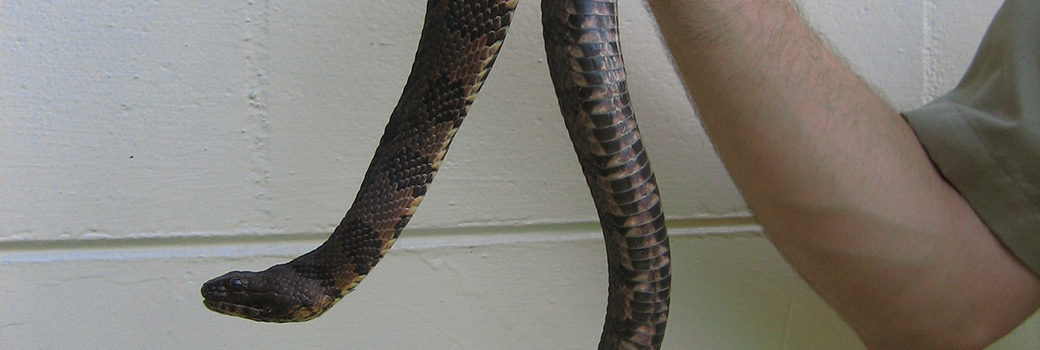- Charlotte Educational Article of the Month - The Northern Water Snake
The Northern Water Snake
The Northern Water Snake
Appearance
Northern water snakes commonly appear in dark-colored shades either in brown, tan or gray.
The back and sides of this Charlotte snake have square patterns that may connect with one another to
make bands. Sometimes, adult northern water snakes may come in solid colors too such as brown
or black. Their underside may appear white, yellow or orange in color with dark half moon shaped
patterns or edges. Young northern water snakes may appear red-brown with a mixture of tan, brown,
or gray. Male northern water snakes tend to be smaller than females. Northern water snakes are
considered to be medium to large North Carolina snakes as they grow from up to 61 to 140 centimeters! At birth,
they are at least 19 centimeters but can go up to 27 centimeters.

Biology
These Charlotte snakes are clasified uner the species of Nerodia sipedon. They are relatively large, non-venemous
snakes. They are often mistaken for venomous snakes such as water moccasins.
Life Cycle
Northern water snakes are known to live up to nine years when in captivity but as for their life
expectancy in the wild, it is still undetermined. Male northern water snakes will reach sexual
maturity in just 21 months and will begin mating at that time but females will only begin to breed
when they are 3 years of age. The females will then produce a single litter (4 - 99 offspring) once
a year. Young northern water snakes are born alive.
Habitat
Northern water snakes are mostly found in the southern areas of Ontario,
Canada and can be found northern states of the US such as:
• Nebraska
• Kansas
• North Carolina
• Missouri
As their name suggests, these Charlotte snakes are aquatic creatures and will live in:
• Rivers
• Streams
• Sloughs
• Lakes
• Ponds
• Bogs
• Marhes
• Impoundments
They venture out onto land - especially young northern water snakes but do not stray to far
from their aquatic environment.
You can stumble upon such creatures under:
• Flat rocks
• Logs
• Boards
Diet
These snakes are considered both carnivores and scavengers which will allow them to eat a varied set of prey such as:
• Amphibians (frogs and tadpoles)
• Fish
• Crayfish
• Insects
• Leeches
• Turtles
• Birds
• Small mammals (mice)
• Other snakes
Behavior
Northern water snakes socialize with their kind only during the fall and spring seasons. During this time,
they may congregate in what are known as "basking sites", coiled together. But the rest of the time, they
are solitary creatures and found in overhanging branches. They are active equally both in the day and night
but surprisingly, are most active during the day. Despite being non-venomous, they are very aggressive and
should be approached or handled with caution.
To learn more about our services, visit the Charlotte wildlife removal home page.

